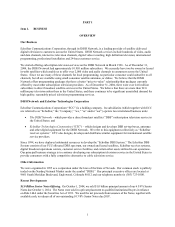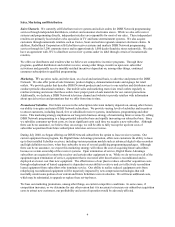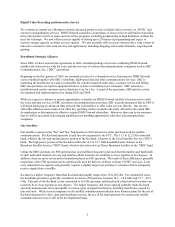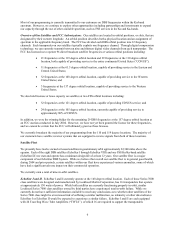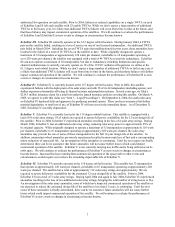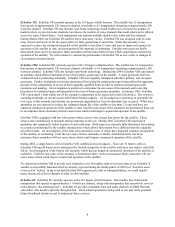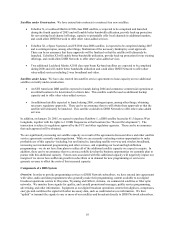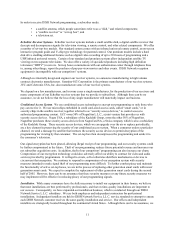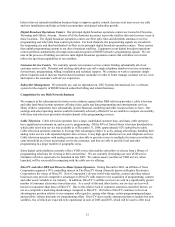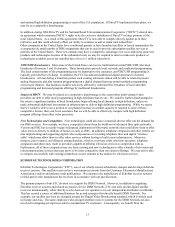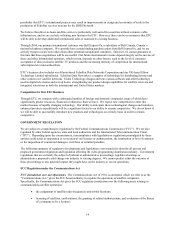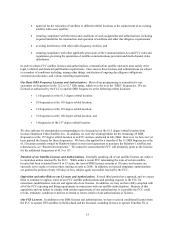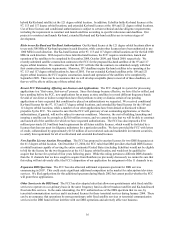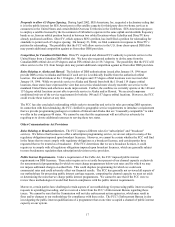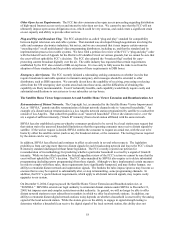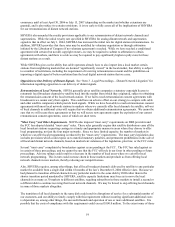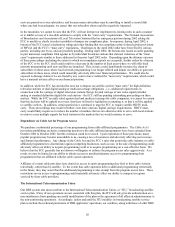Dish Network 2004 Annual Report Download - page 18
Download and view the complete annual report
Please find page 18 of the 2004 Dish Network annual report below. You can navigate through the pages in the report by either clicking on the pages listed below, or by using the keyword search tool below to find specific information within the annual report.10
Satellites under Construction. We have entered into contracts to construct four new satellites.
• EchoStar X, a Lockheed Martin A2100 class DBS satellite, is expected to be completed and launched
during the fourth quarter of 2005 and will enable better bandwidth utilization, provide back-up protection
for our existing local channel offerings, capacity to potentially offer local channels in additional markets,
and could allow DISH Network to offer other value-added services.
• EchoStar XI, a Space Systems Loral FS1300 class DBS satellite, is expected to be completed during 2007
and is contingent upon, among other things, finalization of the necessary bankruptcy court approvals.
There can be no assurance that these approvals will be finalized or that the satellite will ultimately be
launched. EchoStar XI will enable better bandwidth utilization, provide back-up protection for our existing
offerings, and could allow DISH Network to offer other value-added services.
• Two additional Lockheed Martin A2100 class spot beam Ka-band satellites are expected to be completed
during 2008 and will enable better bandwidth utilization and could allow DISH Network to offer other
value-added services including 2-way broadband and video.
Satellites under Lease. We have also entered into satellite service agreements to lease capacity on two additional
satellites currently under construction.
• An SES Americom DBS satellite expected to launch during 2006 and commence commercial operations at
an orbital location to be determined at a future date. This satellite could be used as additional backup
capacity and to offer other value-added services.
• An additional satellite expected to launch during 2006, contingent upon, among other things, obtaining
necessary regulatory approvals. There can be no assurance that we will obtain these approvals or that the
satellite will ultimately be launched. This satellite could allow DISH Network to offer other value-added
services.
In addition, on January 20, 2005, we agreed to purchase Rainbow 1, a DBS satellite located at 61.5 degrees West
Longitude, together with the rights to 11 DBS frequencies at that location (See “Recent Developments”). The
transaction is subject to regulatory approval by the FCC and other regulatory agencies. There can be no assurance
that such approval will be obtained.
We are significantly increasing our satellite capacity as a result of the agreements discussed above and other satellite
service agreements currently under negotiation. While we are currently evaluating various opportunities to make
profitable use of this capacity--including, but not limited to, launching satellite two-way and wireless broadband,
increasing our international programming and other services, and expanding our local and high definition
programming—we do not have firm plans to utilize all of the additional satellite capacity we expect to acquire. In
addition, there can be no assurance that we can successfully develop the business opportunities we currently plan to
pursue with this additional capacity. Future costs associated with this additional capacity will negatively impact our
margins if we do not have sufficient growth in subscribers or in demand for new programming or services to
generate revenue to offset the costs of this increased capacity.
Components of a DBS System
Overview. In order to provide programming services to DISH Network subscribers, we have entered into agreements
with video, audio and data programmers who generally make their programming content available to our digital
broadcast operations centers in Cheyenne, Wyoming and Gilbert, Arizona, via commercial satellites or fiber optic
networks. We monitor those signals for quality, and can add promotional messages, public service programming,
advertising, and other information. Equipment at our digital broadcast operations centers then digitizes, compresses,
encrypts and combines the signal with other necessary data, such as conditional access information. We then
“uplink” or transmit the signals to one or more of our satellites and broadcast directly to DISH Network subscribers.



